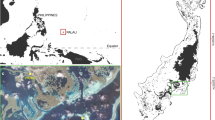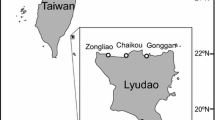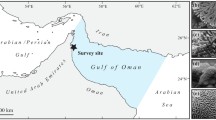Abstract
Evidence is presented that at least 60% of the 184 species of scleractinian corals found on reefs surrounding the Houtman Abrolhos Islands (Western Australia) participate in a late summer mass spawning. These populations are thus reproductively active, despite most species being at the extreme southern limit of their latitudinal range (28° 29°S). In the present study, coral mass spawning occurred in the same month on both temperate (Houtman-Abrolhos) and tropical (Ningaloo) reefs of Western Australia, despite more than two months difference in the timing of seasonal temperture minima between the two regions. This concurrence in the month of spawning suggests that temperature does not operate as a simple direct proximate cue for seasonal spawning synchrony in these populations. Seasonal variation in photoperiod may provide a similar and more reliable signal in the two regions, and thus might be more likely to synchronize the seasonal reproductive rhythms of these corals. Also there is overlap in the nights of mass spawning on the Houtman Abrolhos and tropical reefs of Western Australia, despite significant differences in tidal phase and amplitude between the two regions. This indicates that tidal cycle does not synchronize with the night(s) of spawning on these reefs. Spawning is more likely to be synchronised by lunar cycles. The co-occurrence of the mass spawning with spring tides in Houtman Abrolhos coral populations may be evidence of a genetic legacy inherited from northern, tropical ancestors. Micro-tidal regimes in the Houtman Abrolhos region may have exerted insufficient selective pressure to counteract this legacy.
Similar content being viewed by others
References
Babcock RC (1984) Reproduction and distribution of two species of Goniastrea (Scleractinia) from the Great Barrier Reef Province. Coral Reefs 2:187–195
Babcock RC, Bull GD, Harrison PL, Heyward AJ, Oliver JK, Wallace CC, Willis BL (1986) Synchronous spawning of 105 scleractinian coral species on the Great Barrier Reef. Mar Biol 90:379–394
Colin PL, Clavijo IE (1988) Spawning activity of fishes producing pelagic eggs on a shelf edge coral reef, southwestern Puerto Rico. Bull Mar Sci 43:249–279
Cresswell GR (1991) The Leeuwin Current-observations and recent models. J R Soc West Aust 74:1–14
Cresswell GR, Golding TJ (1980) Observations of a south flowing current in the south-eastern Indian Ocean. Deep-Sea Res 27:449–466
Easton AK (1990) The tides of the continent of Australia. Horace and Lamb Center for Oceanographic Studies, Adelaide. Res Pap 37
Fairbridge RW (1950) Recent and Pleistocene coral reefs of Australia. J Geol 58:330–401
Fox GA (1989) Consequences of flowering-time variation in a desert annual: adaptation and history. Ecology 70:1294–1306
Harrison PL, Wallace CC (1990) Reproduction, dispersal and recruitment of scleractinian corals. In: Dubinsky Z (ed) Coral reefs. Elsevier, Amsterdam, pp 133–207
Harrison PL, Babcock RC, Bull GD, Oliver JK, Wallace CC, Willis BL (1984) Mass spawning in tropical reef corals. Science 223: 1186–1189
Hauenschild C (1960) Lunar periodicity. Cold Spring Harbor Symp Quant Biol 25:491–497
Hoffman RJ (1978) Environmental uncertainty and evolution of physiological adaptation in Colias butterflies. Am Nat 112:999–1015
Hunter CL (1988) Environmental cues controlling spawning in two Hawaiian corals: Montipora verrucosa and M. dilatata. Proc 6th Int Coral Reef Symp Townsville 2:727–732
Jokiel PL, Ito RY, Liu PM (1985) Night irradiance and synchronization of lunar spawning of larvae in the reef coral Pocillopora damicornis (Linnaeus) Mar Biol 88:1667–174
Kennedy B, Pearse JH (1975) Lunar synchronization of the monthly reproductive rhythm in the sea urchin Centrostephanus coronatus Verrill. J Exp Mar Biol Ecol 17:323–331
Kochmer JP, Handel SH (1986) Constraints and competition in the evolution of flowering phenology. Ecol Monogr 56:303–325
Kojis BL (1986) Sexual reproduction in Acropora (Isopora) (Coelerenterata: Scleractinia). II. Latitudinal variation in A. palifera from the Great Barrier Reef and Papua New Guinea. Mar Biol 91:311–318
Minchin D (1993) Multiple species, mass spawning events in an Irish sea lough: the effect of temperatures on spawning and recruitment of invertebrates. Inv Reprod Develop 22:229–238
Murray SP, Arief D (1988) Throughflow into the Indian Ocean thorough the Lombok Strait, January 1985–January 1986. Nature 333:444–447
Oliver JK, Babcock RC, Harrison PL, Willis BL (1988) The geographic extent of mass coral spawning: clues to proximate and ultimate factors. Proc 6th Int Coral Reef Symp, Townsville 2:803–810
Oliver JK, Babcock RC (1992) Aspects of the fertilization ecology of broadcast spawning corals: sperm dilution effects and in situ measurements of fertilization. Biol Bull 183:409–417
Pearce AF (1986) Sea temperatures off Western Australia. Fish Ind News Serv 19:6–9
Pearse JS, Eernisse DJ (1982) Photoperiodic regulation of gametogenesis and gonadal growth in the sea star Pisaster ochraceus Mar Biol 67:121–125
Richmond RH, Hunter CL (1990) Reproduction and recruitment of corals: comparisons among the Caribbean, the tropical Pacific and the Red Sea. Mar Ecol Prog Ser 60:185–203
Salisbury FB (1961) Photoperiodism and the flowering process. Ann Rev Plant Physiol 12:293–326
Saunders DS (1981) Insect photoperiodism. In: Aschoff Y (ed) Handbook of behavioral physiology. Plenum Press, New York vol 4, pp 411–447
Shlesinger Y, Loya Y (1985) Coral community reproductive patterns: Red Sea versus the Great Barrier Reef. Science 228:1333–1335
Simpson CJ (1985) Mass spawning of scleractinian corals in the Dampier Archipelago and the implications for management of coral reefs in Western Australia. Western Australian Department of Conservation and Environment, Perth, Bull 244
Simpson CJ (1987) Growth, metabolism and reproduction of corals in northwest Australia. PhD Thesis University of Western Australia 238pp
Simpson CJ (1988) Ecology of scleractinian corals in the Dampier Archipelago, Western Australia. Techn Ser No 23, Environmental Protection Authority, Perth, Western Australia
Simpson CJ (1991) Mass spawning of corals on Western Australian reefs and comparisons with the Great Barrier Reef. J R Soc West Aust 74:85–92
Simpson CJ, Masini RJ (1986) Tide and seawater temperature data from the Ningaloo Reef tract, Western Australia and implications for mass spawning. Western Australian Department of Conservation and Environment, Perth, Bull 253
Szmant AM (1986) Reproductive ecology of Caribbean reef corals. Coral Reefs 5:43–53
Szmant AM (1991) Sexual reproduction by the Caribbean reef corals Montastrea annularis and M. cavernosa. Mar Ecol Prog Ser 74:13–25
Veron JEN (1974) Southern geographic limits to the distribution of Great Barrier Reef hermatypic corals. Proc 2nd Int Coral Reef Symp Brisbane 1:465–473
Veron JEN, Marsh LM (1988) Hermatypic corals of Western Australia: records and annotated species lists. Rec West Aust Mus, Perth, Suppl 29
Willis BL, Oliver JK (1990) Direct tracking of coral larvae: implications for dispersal studies of planktonic larvae in topographically complex environments. Ophelia 31:145–162
Willis BL, Babcock RC, Bull GD, Harrison PL, Heyward AJ, Oliver JK, Wallace CC (1985) Patterns in the mass spawning of corals on the Great Barrier Reef from 1981–1984. Proc 5th Int Coral Reef Cong Tahiti 4:343–348
Yamaguchi M (1987) Occurrences and persistency of Acanthaster planci pseudo-populations in relation to oceanographic conditions along the Pacific coast of Japan. Galaxea 6:277–288
Yonge CM (1940) The biology of reef building corals. Scient Rep Gt Barrier Reef Exped 1:353–391
Author information
Authors and Affiliations
Rights and permissions
About this article
Cite this article
Babcock, R.C., Wills, B.L. & Simpson, C.J. Mass spawning of corals on a high latitude coral reef. Coral Reefs 13, 161–169 (1994). https://doi.org/10.1007/BF00301193
Accepted:
Issue Date:
DOI: https://doi.org/10.1007/BF00301193




